Remember Airmail? When I was a kid U.S. Airmail was used whenever we wanted to get a letter somewhere quickly. It all started August 12, 1918, when the Post Office took over airmail service from the United States Army. Four pilots were hired. Each had over 1000 hours flying time and they were paid an average of $4000 each – a pretty good salary at that time. The department was first in Washington D.C., but soon moved to College Park, MD. Flights were made from there to Philadelphia.
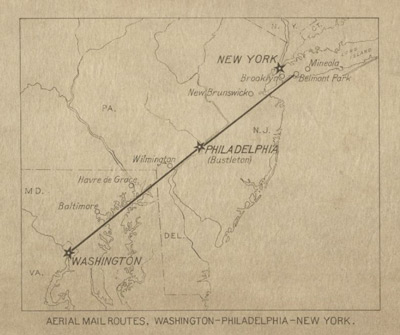
Airmail route, 1918
The first regularly scheduled airmail route connected New York and Washington, D.C., via Philadelphia, from May 15, 1918, to May 31, 1921. The Post Office Department operated the 218-mile route to demonstrate that mail transportation by airplane was possible on a regular schedule in all kinds of weather.
The first airplanes used were WW I surplus de Haviland DH-4 planes. These planes weren’t much, and they certainly weren’t made for cross-country flying. A better plane was the Standard Aircraft JR-1B. It could carry 300 pounds of mail, along with the 60 gallons of fuel. The German-made all-metal Junkers F-13 was imported, and it was hoped the plane would be better. However, it wasn’t long, and several pilots were killed in blazing crashes while flying the plane. It was pulled from service.
The post office hired 40 pilots and by 1920 had delivered over 49 million letters. It worked! In the first year, U.S. Airmail service costs were $143,000. Income was $162,000. That’s called a profit…
Bankers were big customers for the fledgling service. They could now send checks and financial papers, expecting them to arrive quickly. In July 1919, the extra fees charged for Airmail were removed. But the charges were reinstated when transcontinental Airmail commenced in 1924.
International Airmail began on the 3rd of March 1919, when Bill Boeing and Eddie Hubbard flew 60 letters from Vancouver, British Columbia to Seattle, Washington, using a Boeing Model C. Before the year was out, Hubbard began flying the mail between Seattle, and Victoria, B.C, using a Boeing B-1 flying boat. He was to amass over 350,000 miles on the plane in the next eight years!
A major problem for flying mail was that the pilots were supposed to fly in all kinds of weather. Can you imagine flying a plane when you could only see 200 feet ahead of you? The pilots balked at this, and it wasn’t long and field managers would make the decision if it was safe to fly or not. The pilots were no longer required to risk their lives.
Airmail was here to stay. It was in flight for 59 years – from August 12, 1918, to May 1, 1977. In actuality, the service ended in 1975, when First Class postage came into play, costing three cents less than Air Mail.
The following maps and captions are from the Postal Service website at: https://about.usps.com/who-we-are/postal-history/airmail-route-maps.pdf
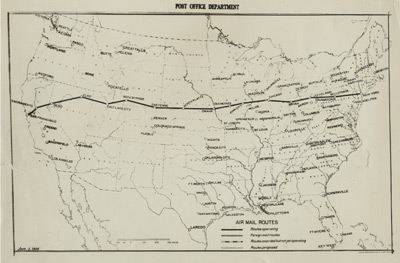
Airmail routes, January 1, 1926
A 2,680-mile-long transcontinental airmail route linking New York with San Francisco was completed in 1920. Initially, mail was flown by day and carried on trains at night. One coast-to-coast trip took about 3 ½ days, which was nearly a day quicker than the all-rail time. Regular service with night flying began in 1924, reducing the trip to about 33 hours. The Airmail routes from Seattle to Victoria, British Columbia, and from New Orleans to Pilottown, Louisiana, were foreign airmail routes, operated under contract — they expedited mail delivery to foreign-bound steamships.
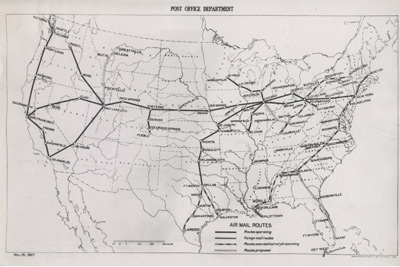
Airmail routes, November 15, 1927
The first branch lines off the New York–San Francisco transcontinental route opened in February 1926. These branches or “feeder” routes were operated under contract. Post Office Department personnel continued to operate the transcontinental route until July 1, 1927 (west of Chicago) and September 1, 1927 (east of Chicago), when the service was turned over to contractors. A foreign airmail route linked Key West, Florida, with Havana, Cuba, from 1920 to 1923 and again from 1927 to 1928.

Airmail routes, June 1, 1929
The airmail network continued to expand in the late 1920s, with over 14,400 miles of route established by June 1929. Congress authorized long-term contracts for foreign airmail service in March 1928; in October 1928, Foreign Air Mail Route 1 began regular service between New York and Montreal. Beginning in 1929, foreign airmail routes linked Brownsville, Texas, with Mexico City; and Miami with cities in Central and South America and the Caribbean.
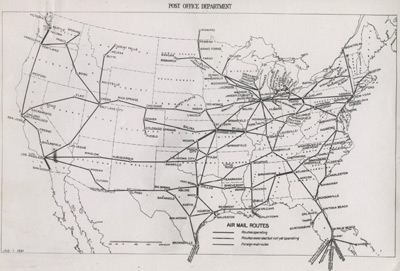
Airmail routes, July 1, 1931
Two new transcontinental routes were established in 1931, from Atlanta to Los Angeles, and from New York to Los Angeles. The Post Office Department encouraged passenger transportation — all but two airmail routes carried passengers in addition to mail. Carriers were paid more to transport mail if they used larger aircraft capable of carrying more passengers.
3 more maps available – 1934 – 1939 – 1946 at: https://about.usps.com/who-we-are/postal-history/airmail-route-maps.pdf
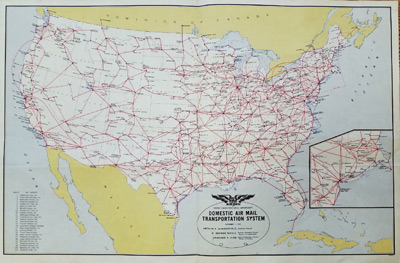
Airmail routes, November 1, 1955
In 1953, the Post Office Department began transporting ordinary letters by air experimentally on a space-available basis between select cities. Two decades later, air transportation had become so commonplace that in 1975 the Postal Service announced that all domestic First-Class Mail would start receiving the same service as airmail. Airmail as a special service was officially discontinued in 1977.